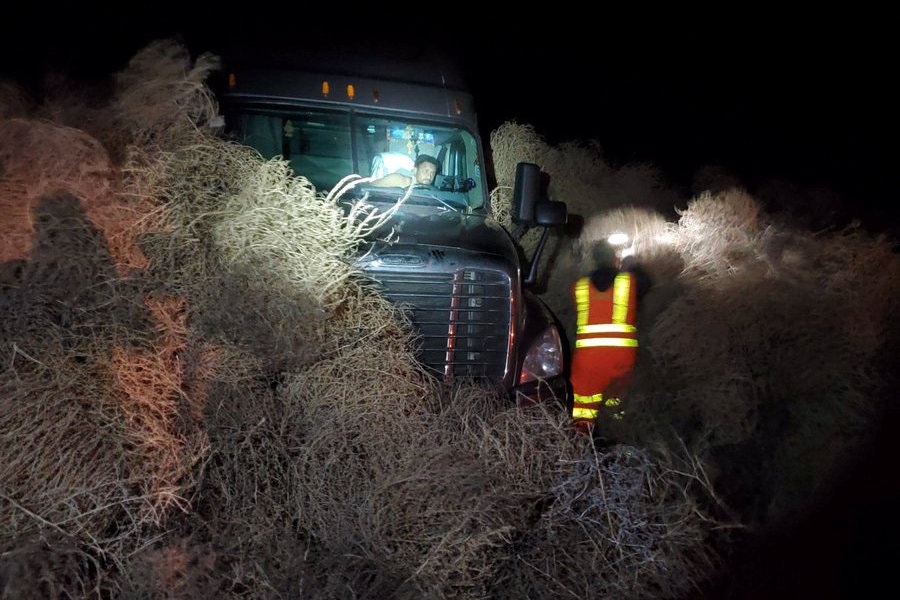TUMBLEGEDDON
The Rise of Tumbleweed

On January 2, 2020, The New York Times reported:
In ghost towns and gunslinger movies, they drift in ones or twos, cast wherever the wind takes them. Along a long stretch of road in Washington State, the tumbleweeds took over instead: more like monsters out of science fiction than lonely icons of the American West. On New Year’s Eve, hundreds of them tumbled over and onto a highway, State Route 240, covering a stretch three football fields long. In some places they piled up 30 feet high, trapping cars and trucks for hours. By the end of the night, the authorities were calling it “Tumblegeddon.” . . . Crews from the Washington State Department of Transportation used snowplows and their hands to clear the tumbleweeds, which amassed near the city of Richland, in a more arid part of the state about 200 miles southeast of Seattle. Officials closed 20 miles of the highway so crews could clear the road. It took 10 hours to move the tumbleweeds.
"I’ve worked here in southeastern Washington State for over 20 years. We always experience high winds and tumbleweeds rolling down the road, but I’ve never seen an accumulation like this before."
- Trooper Chris Thorson, Washington State Patrol
"We’ve had issues in the past but we’ve never seen them come this quick. We’re talking a real quick overnight stacking."
- David Mosley, Washington state Department of Transportation spokesman
"Some people are calling them nuclear tumbleweeds."
- Trooper Chris Thorson, Washington State Patrol
"Is this the new Sharknado?"
- Scott DeVoe, Syfy channel subscriber
What exactly is tumbleweed anyway? According to Northern Arizona University, it's actually an invasive species:
One example of a famous and very successful invasive plant is the tumbleweed, or Russian thistle. This iconic symbol of the West is actually an invasive species from Russia that causes serious ecological problems. For instance, tumbleweeds play an active role in wind induced soil erosion. When tumbleweeds die, they uproot from the ground and as the wind blows them across the desert terrain, they loosen the top soil layer making it more prone to wind erosion.
Although Russia has denied any involvement in Tumblegeddon, President Trump purportedly called President Putin to congratulate him on the first successful deployment of the Russian thistle system known as Avangard. "I thought it would be faster," he said.
Michael Bay is said to be in talks to acquire the rights to this story.
"Storm of Tumbleweeds Buries Cars, Terrifies Drivers and Astounds Police"
- The New York Times
"30-foot tumbleweed pileup traps cars, semi-truck on Washington highway"
- NBC News
"Tumbleweed avalanche hits highway in Washington and buries cars"
- Daily Mail
"Washington state police spend 10 hours digging out cars buried by tumbleweeds on New Year's Eve"
- USA Today
"Did you see the videos of that crazy tumbleweed storm?"
- The Oregonian
What the internet is saying
Our crews are continuing to keep watch on SR 240 and the tumbleweed impacts there. They will be patrolling through this evening to help keep the road open to traffic. Please take care if you choose to travel through this area as winds continue to move the tumbleweeds around. pic.twitter.com/d6dlQPvESL
— WSDOT East (@WSDOT_East) January 1, 2020
Hundreds of tumbleweed have forced the closure of SR 240 in Benton County, Washington. pic.twitter.com/A5V5iCR5r9
— KOKH FOX 25 (@OKCFOX) January 2, 2020
#tumblegeddon After 10 hours of SR 240 being closed last night on New Year’s Eve, it was opened around 0430 thanks to @WSDOT_East We still have one abandon car trapped in the tumbleweeds that was found at daylight, luckily no one was in it. pic.twitter.com/df7XbnqafE
— Trooper C. Thorson (@wspd3pio) January 1, 2020
How you can help
If you would like to donate to the families of the Tumblegeddon victims, please visit the Tumblegeddon gofundme page.
If you are unable to donate, please consider this great alternative. According to the Nature Conservancy, the best way to address invasive species such as the Russian thistle is to prevent their initial introduction into the environment. By following these six guidelines, you can help prevent future catastrophes like Tumblegeddon:
- Verify that the plants you are buying for your yard or garden are not invasive. Replace invasive plants in your garden with non-invasive alternatives. Ask your local nursery staff for help in identifying invasive plants!
- When boating, clean your boat thoroughly before transporting it to a different body of water.
- Clean your boots before you hike in a new area to get rid of hitchhiking weed seeds and pathogens.
- Don't "pack a pest" when traveling. Fruits and vegetables, plants, insects and animals can carry pests or become invasive themselves. Don't move firewood (it can harbor forest pests), clean your bags and boots after each hike, and throw out food before you travel from place to place.
- Don't release aquarium fish and plants, live bait or other exotic animals into the wild. If you plan to own an exotic pet, do your research and plan ahead to make sure you can commit to looking after it.
- Volunteer at your local park, refuge or other wildlife area to help remove invasive species. Help educate others about the threat. You can even volunteer with The Nature Conservancy.
News coverage
"Storm of Tumbleweeds Buries Cars, Terrifies Drivers and Astounds Police"
- The New York Times
"30-foot tumbleweed pileup traps cars, semi-truck on Washington highway"
- NBC News
"Tumbleweed avalanche hits highway in Washington and buries cars"
- Daily Mail
"Washington state police spend 10 hours digging out cars buried by tumbleweeds on New Year's Eve"
- USA Today
"Did you see the videos of that crazy tumbleweed storm?"
- The Oregonian